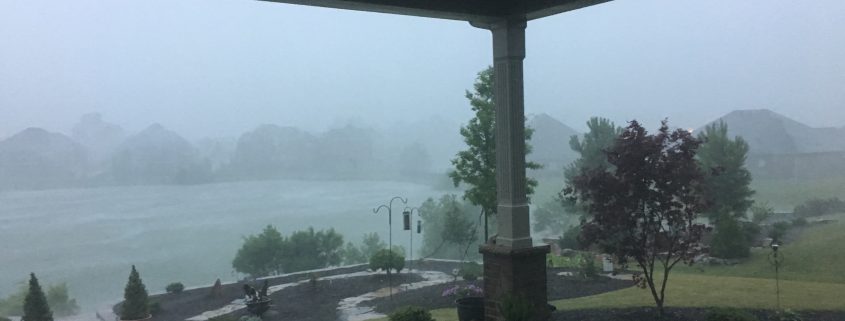June 22, 2018 Squall on Big Blue Lake
I am a hopeless weather junkie — addicted for life! I’ve included essays recounting personal episodes with Nature’s pleasurable terror in both Nature Based Leadership and Nature-Inspired Learning and Leading. A meteorologist friend in New Hampshire declared us weather perverts — we both thrill at weather that is harsh and threatening. For example, we believe that nothing beats a strong winter Nor’easter. The more snow and wind the merrier.
One of my most memorable life-days was the Storm of The Century, The Blizzard of 1993, when we lived in State College, Pennsylvania. March 13 brought 28 inches of new snow and winds gusting to 65 miles per hour, along with thunder and lightning. I stayed nose-pressed-to-the-windows for hours, venturing out once in a while to shovel and soak up the storm via all five portals: body, heart, mind, soul, and spirit. A sensory feast beyond compare!
The second of many special memorable moments came during a winter summit attempt on New Hampshire’s Mount Washington in February 2015. We made it to 5,300-feet before nearly hurricane force winds, temperatures well below zero, and ten-foot drifts forced us to abort. The permanently-staffed station at the summit observatory (6,288-feet) registered winds in excess of 100 with ambient air temperature at 20 below. And we were guests of the Observatory ascending in an Arctic Cat!
My life is rich with tales of pleasurable terror. This past Friday in an air mass of deep tropical moisture from the Gulf, several thundershowers passed during the day. This one strengthened rapidly as it approached and built over us. Later I watched it blossom on radar, hitting us with intense rain and strong wind. It peaked impressively during this 22-second video recording on my iPhone.
I will never tire of Nature’s Pleasurable Terror, although this one came close to a threshold of concern. Great entertainment!
May Nature inspire all that you do! Her beauty, magic, wonder, and awe are available for those who seek Nature’s dividends.
Thunderstorms in such air masses are Nature’s venting mechanisms, release valves for the tremendous energy generated by summer’s southern sun and a moisture-rich unstable atmosphere. We all have our own coping and venting mechanisms. I bike, lift weights (yeah, at age 67 they are light weights!), hike, and stay busily engaged in living. I did same during my four university presidencies. We all need to let off steam under conditions that, to the extent possible, we control.
Nature copes quite well normally, releasing pressures and seeking balance harmlessly and routinely. But not always. Once in a while she throws a hand-grenade — Mount Saint Helens; the Alaska Good Friday Earthquake; the Storm of the Century; Sandy; Katrina; and other epic events. Last Friday’s squall amounted to a minor venting, reaching near-damaging wind yet bringing down only a few twigs and leaves.
We deal commonly with minor venting in our life and enterprise. Like Friday’s storm, most such minor life perturbations are predictable and somewhat routine. It’s only when the wind rises that coping exceeds a threshold, requiring cleanup, rebuilding, and recovery.
Nature teaches that venting is a fact of life; that preparation and anticipation are essential; and that sometimes we are dealt more than we can easily handle.
I thought as I watched the squall, what if I had heard the terrible fright train roar of an approaching tornado? Pleasurable terror would have shifted to the cold fear of absolute TERROR. Even then, because we built in a region where tornadoes are not rare, we have a tornado shelter. We would have taken shelter, and prayed for escape.
Fortunately, this cell did not spin-off that kind of savage beast, nor did it warrant even a severe thunderstorm warning. As a result, I consign it to my personal memory bank of notable pleasant weather memories. Life, living, and all things natural align along a continuum… from soft and benign to wildly catastrophic. Blessedly, the frequency curve peaks at soft and benign. The savage extremes are as rare today as they’ve been over the course of human history. There are, and always have been, Storms of the Century. Our Earth and its processes are dynamic and occasionally turbulent. We hear far more about the extremes today for at least these reasons:
- We understand, measure, monitor, and video record orders of magnitude more closely than ever.
- We now number eight billion humans, subjecting more and more of us to harm’s way.
- We occupy coastal zones, riverine systems, tectonically active regions, and other areas subject to Nature’s ravage more than ever.
Lessons from Nature’s Fury
We live in Nature’s cross-hairs, too often ignoring the risks we impose. We tempt fate by failing to recognize the peril we self-select. Will we ever learn? Can we become informed, responsible stewards of this One Earth? We have just this one chance to get it right. So far as we know, we are alone in the vast darkness of space. No one will be coming to rescue us from ourselves.
A wee thundershower, a welcome deep-south summer diversion, serves as a vivid reminder of Nature’s ways. Ways that are both wondrous and terrifying; relentless and inescapable; gentle and all-powerful. Ways that are generally predictable; rules that are constant and immutable. Laws that we cannot breech but at our peril.
Do your part to understand our place in the world… our role in assuring humanity’s future. We face a potential tsunami of unintended consequences. On so many human/environment fronts, we are pushing past a threshold of soft and benign venting.
On a lighter note, learn first to enjoy Nature’s beauty, magic, wonder, and awe — whether in form of a brief summer tempest… or the rainbow that follows.



